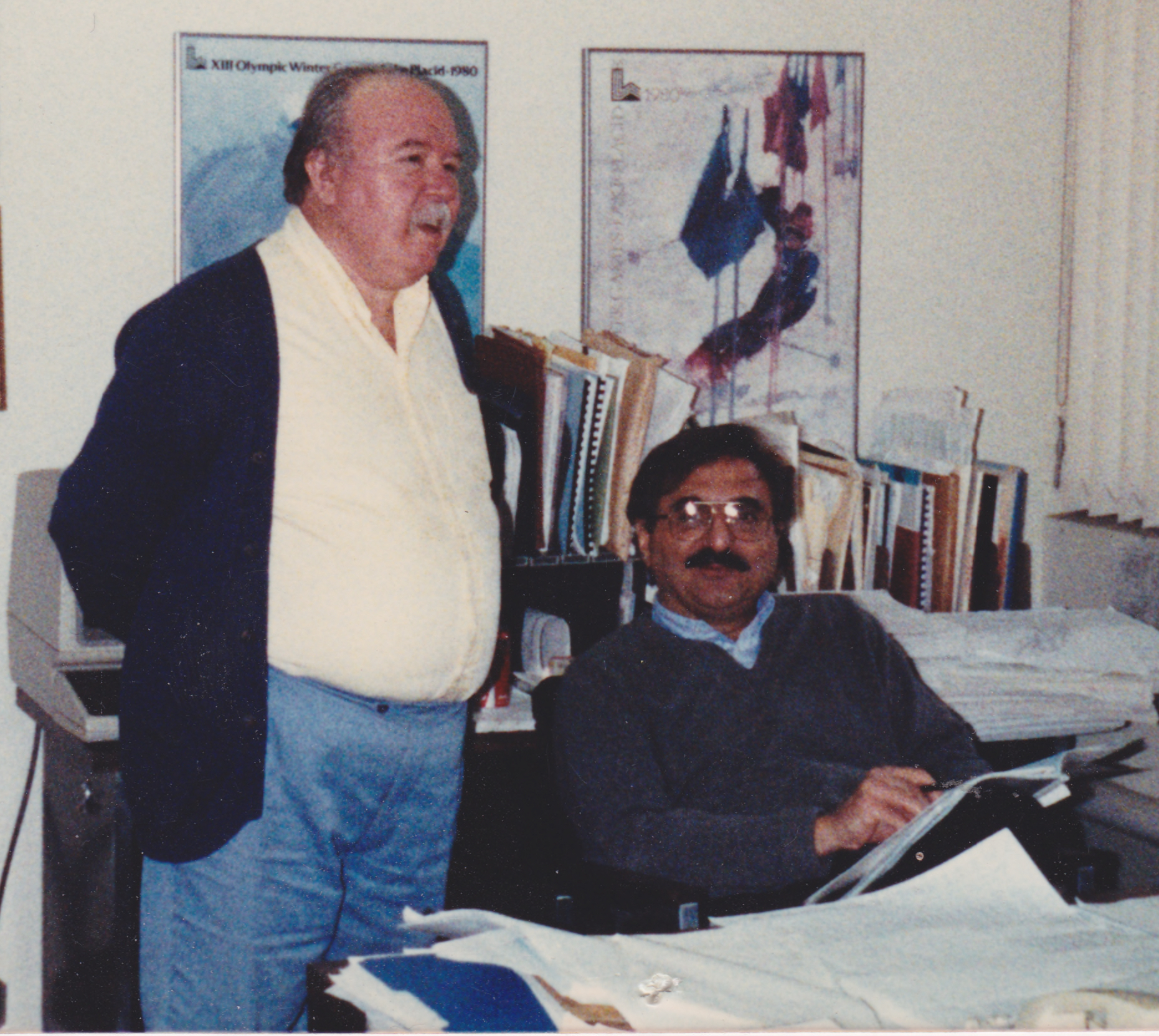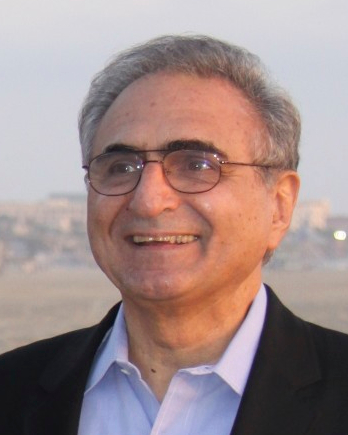Oceanweather
Inc. (OWI) was formed in 1977 as a small business in White
Plains, NY (USA). The original principals
in the company, Dr. V. J. Cardone, Dr. J. A. Greenwood and
Ms. C. V. Greenwood, had worked together on federally-sponsored
research programs at New York University and the City University
of New York, where Dr. Cardone was Associate Professor of
Meteorology and Oceanography. The group were an integral
part of the team which in the late 1960's, under the supervision
of Professor Willard J. Pierson of New York University,
developed and transferred to the U.S. Navy Fleet Numerical
Oceanography Center (FNOC), the first spectral ocean wave model (SOWM)
used for operational hemispheric real-time wave forecasting. |

Dr. Vince Cardone
and Dr. Arthur Greenwood, 1989 |
OWI later developed a global version of the FNOC model (GSOWM),
which was implemented in 1985 and operated until 1994.
In the early 1980's, a new second-generation wave
model (2G) was developed at Oceanweather under sponsorship
of the U.S. NOAA Sea-Air Interaction Laboratory (the SAIL
model: Greenwood, Cardone and Lawson, 1985). That model
was later implemented as NOAA's operational global model
(the NOW model) for real-time analysis and forecasting,
and was implemented as a regional model by the Norwegian
Meteorological Service (the WINCH model). Wave model development
continued with OWI as the only private firm part of the WAM
group, which developed the first third-generation (3G) spectral
model and in a parallel effort developed its own 3G model.
In the first two years of operation, about 80% of OWI's
support consisted of research grants from NASA, NOAA (National
Oceanic and Atmospheric Administration), and the U.S. Navy.
The remaining 20% consisted of consulting contracts from
the major international oil companies. Thereafter, while
the government-funded work was maintained at a stable level
of support, the offshore industry and coastal engineering
industry supported work grew to constitute the major share
of OWI's revenues by the early 1980s.
In 1983, OWI moved to Cos Cob, CT to accommodate increased
staff and a fully configured super-minicomputer installation.
At the same time, OWI added a real-time forecasting division
to its business in response to desire from several major
international oil companies to apply its high-level technology
to ocean wind and wave prediction. In 1987, one of the founding
principles, C. V. Greenwood, resigned to pursue a career
change and a decade later the other founding principal, J. A. Greenwood,
retired at age 70.
During the 1980s, OWI worked on major Joint Industry
Projects (JIPs) in establishing the hindcast approach
for site operability and design. Following the Ocean Data
Gathering Project (ODGP), a trio of Gulf of Mexico JIP studies
known as GUMSHOE (Gulf of Mexico Hindcast of Oceanographic
Extremes), WINX (Winter Extremes - Gulf of Mexico), and
GLOW (Gulf Long Term Weather) were developed for the offshore
oil and gas industry and have been applied in the design
and certification of the vast majority of offshore structures
in the Gulf. GOMOS (Gulf of Mexico Oceanographic Study)
launched in 1999 and superseded the
original studies. GOMOS remains the database applied by the U.S. regulator
BSEE (Bureau of Safety and Environmental Enforcement) for
licensing offshore structures in the Gulf. The
JIP approach has been expanded to encompass much of the
offshore drilling basins including the North Sea (NEXTRA),
South China Sea (SEAFINE), West Africa (WANE), Arctic (PAMOS),
Sakhalin Island (SIMOS), Northwest Shelf of Australia (NAMOS),
and others.
In the mid-1990s, OWI made a strategic decision
to augment its commissioned projects and consulting service
with in-house studies for marine areas and basins of interest
to the industry. These "speculative" products
are offered on a site-specific basis subject to a licensing
agreement. OWI continues to expand its suite of speculative product offerings and
provides high quality metocean data with particular attention
to the extremes which drive design decisions.
The
2000's brought the development of the first long-term global
and regional reanalysis efforts. OWI's Global Reanalysis
of Ocean Waves (GROW) was the first 40+ year global wave
hindcast and was published in JGR Oceans. An extensive hindcast
effort, supported by Environment Canada, developed the AES40
and MSC50 hindcasts which involved detailed reanalysis for
the North Atlantic and Canadian maritimes. OWI also developed
the wind forcing applied for the U.S. Army Corps of Engineers
Wave Information Study (WIS) for the U.S. East, West, Alaska
and Hawaiian coastlines.
In 2003, Oceanweather became an Employee Stock Ownership
Plan (ESOP) company in which the employees participate as
owners of the company. As an ESOP, employees as owners
are active participants in the success and future of the
company.
Following the devastation of Hurricane Katrina in 2005,
OWI was a key member of the Interagency Performance Evaluation
Task Force (IPET) lead by the U.S. Army Corps of Engineers.
This storm also prompted an evaluation and restudy of the
coastal flood risk for all U.S. Coastlines by the Federal
Emergency Management Agency (FEMA). OWI contributed to studies
in all FEMA regions (U.S. East/West coasts, Gulf of Mexico
and Great Lakes) providing expertise in tropical wind modeling,
extra-tropical storm analysis, and ocean response modeling
needs of the various studies.
During late 2005, OWI formed a joint venture with Danish
Hydraulics Institute (DHI) to develop and market "PERGOS".
PERGOS provides meteorological and oceanographic design
data for the entire Arabian/Persian Gulf. The development
of joint products continued when the Mid Atlantic Current
Hindcast (MACH), a joint venture product between OWI, BMT
Argoss and the MetOffice, was launched in 2015 to provide a comprehensive 3-D
current hindcast for West Africa.

Dr. Vince Cardone,
2012
|
Oceanweather
was saddened by the passing of its founder, Dr. Vincent
Cardone, in November of 2013. It was a great loss to those
who knew him as a teacher, a colleague, a friend,
and a great man. Vince put his heart and soul into Oceanweather
and its employees, and the hard work the company continues
to perform honors his lasting memory. |
Oceanweather has continued its long tradition of active engagement
and publication in the academic community. OWI
has been an active part of the Wave Workshop series of meetings
since its inception in 1986 and is pleased to host the archive
for the metocean community at www.waveworkshop.org.
Oceanweather have a long history of collaboration with the ADCIRC storm surge
model community having co-authored ocean response modeling
efforts for hurricanes Katrina, Rita, Ike, Gustav, Jeanne
and others impacting the U.S. coastline. Wind fields developed
for ocean-response modeling by OWI in tropical and extra-tropical
storms are considered the "gold-standard" for
definitive hindcasts and calibration of ocean response models.
OWI moved to its present location at 350 Bedford Street,
Suite 404, Stamford, CT in the summer of 2016. Remaining true to the founders,
Oceanweather continues to develop, learn, and engage in
metocean modeling and analysis. The team of OWI meteorologists
and ocean engineers are dedicated to improving the science
of producing metocean hindcasts and forecasts worthy of
the exceptional reputation earned in the industry.
